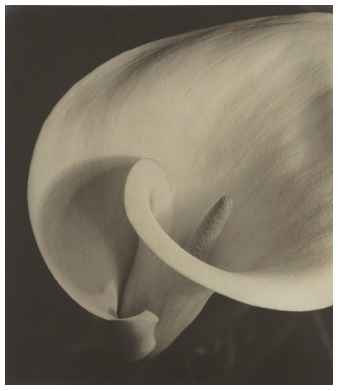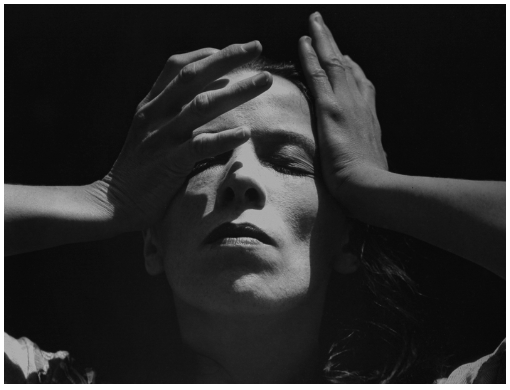Imogen Cunningham was the first American female photographer, which makes her works particularly compelling. She was born in Portland, Oregon in 1883 and began her career in photography 1906 after being inspired by the work of Gertrude Käsebier (“Imogen Cunningham”). I chose to focus on the work Imogen Cunningham for this assignment not only because she paved the way for other female photographers in America but also because her artworks exhibit a great variety of content and aesthetics.
Cunningham’s first job in photography involved taking pictures of flowers and plants for the botany department of the University of Washington in Seattle (“Imogen Cunningham”). This had impacted her future work, which was largely focused on close-up botanical photography. After graduating, Cunningham opened her first studio in Seattle, where she began developing her skill in portrait and nude photography. Cunningham’s work received a critical appraisal, allowing her to enter the field of fashion photography through employment in Vanity Fair (“Imogen Cunningham”). Throughout life, she also explored a variety of genres and methods, such as street photography and commercial studio photography. However, the aesthetics of Cunningham’s artwork allow identifying her personal style. Most of the pictures appear smooth, black and white, with little details in the focus and low contrast, although she also has some works in sepia. The minimalist aesthetics of Cunningham’s photographs allow them to convey a variety of emotions and feelings, thus captivating the viewer.

The first picture chosen for analysis is Calla, created in 1925, which is an excellent example of Cunningham’s botanical photography. The picture focuses on a single white Calla flower, with some leaves and stems visible in the bottom right corner (Cunningham, Calla). The image is in black and white, with yellow undertones that produce a low, smooth contrast. The structure of the plant is a spiral, which provides for added depth due to the arrangement of highlights and shadows. The composition of the image brings forward the texture of the flower with its smooth vertical lines, which supports the eye movement around the image. The visual aesthetics of the picture are appropriate for botanical photography, and they also convey the feeling of tranquility as they emphasize the tenderness of the flower. This feeling is passed on to the viewer, encouraging them to concentrate on their thoughts in connection with the picture. Based on the analysis, this artwork appears to be personal rather than political or commercial due to its calm yet powerful emotional content.

The second piece is one of Cunningham’s most famous works in portrait photography. The face of Martha Graham, a famous American female dancer, is at the focus of this black and white picture (Cunningham, Martha Graham). The high contrast and neutral tones of the image bring to the viewer’s attention a variety of details, including the woman’s hair, her wrinkles, and the unevenness of her skin. The range of textures evident in the picture creates an added depth by highlighting Graham’s face structure and the movement of her hands, thus guiding the viewer’s eyes through the content. Nevertheless, the pose and facial expression draw the most attention due to the feeling of tension and exasperation conveyed by them. The emotions expressed by Graham also create a particular narrative of movement, as if the picture was taken in the middle of a dancing performance. This makes the image appear deeply personal because it connects the reader’s emotions with the ones shown by the model. The work evokes feelings of melancholy and anticipation as if the viewer is waiting to see the rest of Graham’s performance.

The last picture, Triangles, is among the key Cunningham’s works in nude photography. This is a photograph of a woman’s upper body, with a focus on the stomach and breasts (Cunningham, Triangles). Similarly to Calla, this picture uses soft, yellow light to create a smooth aesthetic. The low contrast of the image adds to the feeling of softness, which is also supported by details of the content, such as stomach rolls, smooth skin, and thin body hairs glistening in the light. However, contrary to Calla, Triangles lacks depth, prompting the viewer to focus their attention on the female body by limiting eye movement. The work has a kind and calm energy, which induces the feeling of pleasant tranquility. Similarly to the other works discussed here, Triangles lacks political and commercial content, making it a personal, even intimate, photograph.

One particular photograph I made that resembles the style and aesthetics of Imogen Cunningham can be seen above. This work is also an example of botanical photography and features a close-up of a plant. The picture was taken in black and white, with neutral undertones and a low contrast, which makes it similar to Calla by Imogen Cunningham. However, the two pictures differ by their composition and the number of details. Calla is focused on a single object and has it positioned at the center of the image. My photograph, on the contrary, focuses on several plants, which creates a more complex composition. There are also more details evident in the photo, which creates perspective and contribute to the depth of the photograph. In Calla, depth is achieved through the use of contrast and texture rather than perspective, which is also an essential point of difference. Overall, despite the similarities in terms of content and aesthetic, my work differs from Calla due to its composition. Since I am interested in botanical photography, studying and analyzing Cunningham’s artwork can assist me in improving my personal style and photography skills.
Works Cited
“Imogen Cunningham.” Lumiere Ltd, 2016, Web.
Cunningham, Imogen. Calla. 1925. Norton Simon Museum, Pasadena. Artsy, Web.
Martha Graham. 1931. Ryan Gallery, Gilbert. Artsy, Web.
Triangles. 1928. Metropolitan Museum of Art, New York. Artsy, Web.